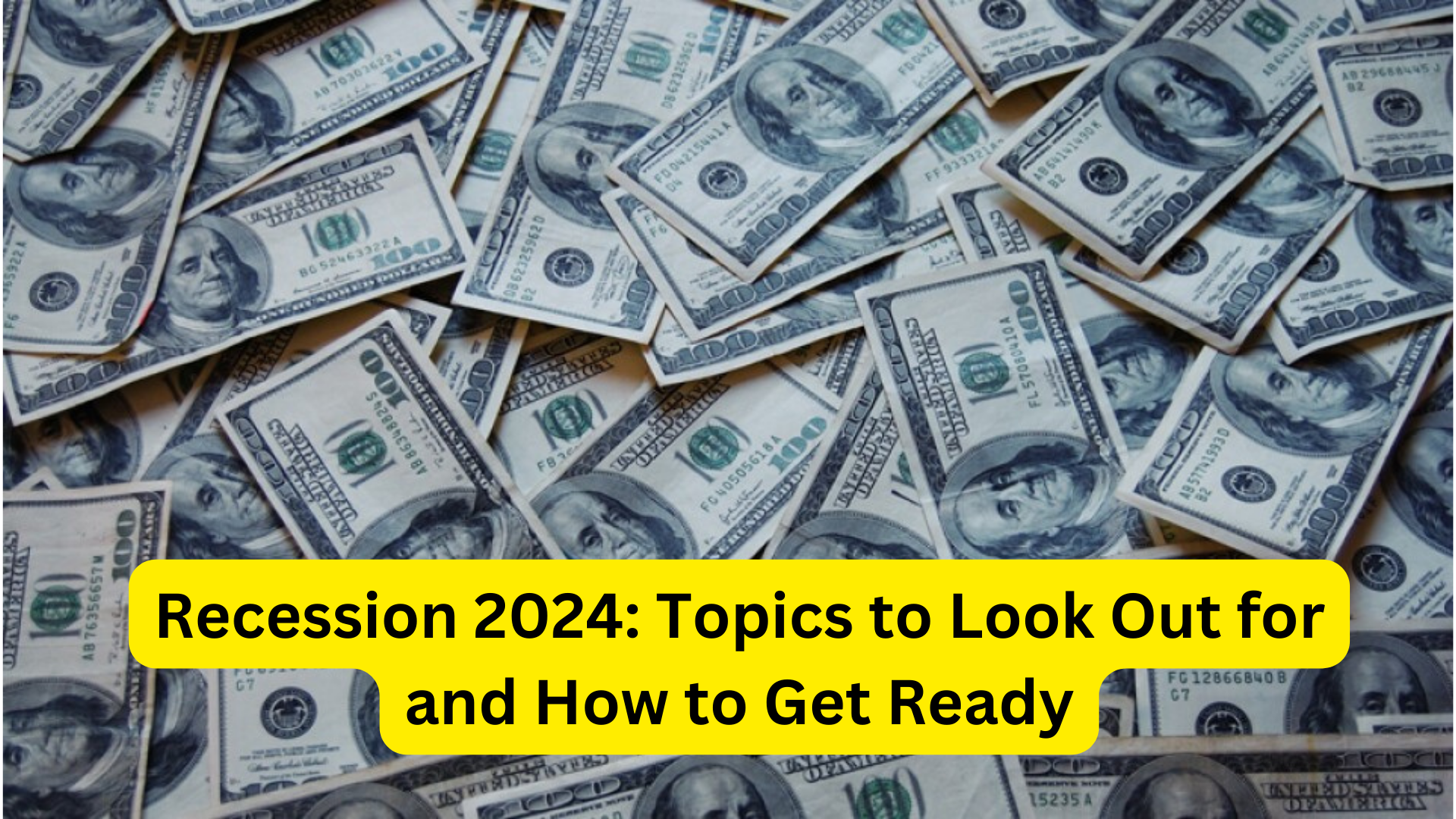Table of Contents
ToggleRecession chances remain elevated heading into 2024.
Compared to a year ago, the U.S. economy is on rather firm ground going into 2024. The labor markets have not changed, inflation has decreased, and the Federal Reserve has hinted that interest rates may drop later in the next year.
The Federal Open Market Committee, or FOMC, members are among the many analysts who predict a soft landing—a slowdown in GDP growth without a recession—for the US economy in 2024. The coming months will be crucial for the central bank since one wrong move on the part of the Fed may easily slow down the economy to the point where a recession is declared.
Economic recessions, which have occurred frequently over the previous century, are not cause for alarm. Investors may, however, take advantage of a challenging scenario by being aware of which risk indicators to monitor and how to arrange their portfolios in the event that a recession occurs in 2024.

Recession Risk Factors for 2024
Recessions can be caused by a wide range of events, but two are unquestionably the greatest threats to economic stability in 2024.
If you’ve been an investor for even a year, you already know that inflation is the main source of economic risk going into 2024. As of November 2023, the year-over-year inflation of the consumer price index has dropped to just 3.1% from a 40-year peak of 9.1% in June 2022.
An increased rate of interest is the second danger factor for 2024. By increasing interest rates to 22-year highs, the Federal Reserve has adopted a strong stance against inflation and has made great strides toward its long-term target of 2% inflation. Increased interest rates make borrowing money more expensive, which deters enterprises from taking on debt to fund expansion. In addition to decreasing consumer spending, higher rates also lessen the demand forces that drive up prices.
Since March 2022, the Federal Reserve has risen interest rates eleven times, increasing the range of its fed funds target rate to between 5.5% and 5.25%. In July 2023, the Fed raised interest rates for the first time. The bond market believes that by March 2024, the Fed will go from raising rates to lowering them, which might boost the economy in light of the most recent inflation trends.
The Federal Reserve can celebrate its accomplishments in 2023, but it may be too soon to declare triumph, according to the most recent core personal consumption expenditures (PCE) price index reading from late November. The Fed’s favorite inflation indicator, core PCE, which takes volatile food and energy costs out of the equation, increased 3.5% year over year in October, much over the FOMC’s 2% objective.
Worse, because of so-called sticky inflation, the last stretch of the inflation war could be the hardest for the Fed to manage. Sticky inflation occurs when the price of some goods and services is resistant to changes in monetary policy. Examples of such products and services include medical supplies, children’s apparel, and vehicle insurance. Sticky inflation may prevent the Fed from hitting its 2% objective for far longer than investors think and compel the central bank to postpone its shift to rate decreases, even if inflation in other sectors of the economy continues to decline.
In 2024, Will There Be a Recession?
The American economy hasn’t yet been negatively impacted by inflation or growing rates. According to the U.S. Bureau of Labor Statistics, the country created 199,000 new jobs in November and the unemployment rate, which is at 3.7%, is still historically low.
In the upcoming months, investors should keep a close eye on the labor market since restrictive monetary policy frequently has a lagged effect on economic development. Although the U.S. GDP expanded by 5.2% in the third quarter of 2023, the most recent economic forecasts from the Federal Reserve indicate that growth will only reach 1.4% in 2024.
Will There Be a Recession in 2024?
Inflation and growth rates haven’t yet had a detrimental effect on the US economy. The U.S. Bureau of Labor Statistics reports that 199,000 new jobs were generated in the nation in November, and the 3.7% unemployment rate is remains historically low.
Investors should closely monitor the labor market in the coming months, since restrictive monetary policy often has a delayed impact on economic development. Despite a 5.2% increase in GDP in the third quarter of 2023, the Federal Reserve’s most current economic predictions for 2024 suggest that growth would only amount to 1.4%.
Strong U.S. consumer spending trends, lowering long-term interest rates, and declining fuel costs, according to Comerica Bank senior economist Bill Adams, indicate that the likelihood of a U.S. recession is going down.
“Consumers are sustaining the U.S. economic expansion,” argues Adams.
“Risk of a recession near term is receding, with prices of gas and home heating down sharply, employment rising and mortgage rates falling.”
According to Chris Zaccarelli, chief investment officer of Independent Advisor Alliance, investors made a grave error in 2023 by being overly cautious about economic concerns, but there are still genuine threats to the U.S. economy in 2024.
“Bears will continue to keep pushing their forecast forward – first by months and next by years – and say that everything they believed in October of 2022 is still true today,” adds Zaccarelli.
“And many of those concerns (e.g., higher interest rates, inflation above target and de-globalization trends) are all still valid, and yet what was missing from their thesis – a resilient labor market and an even more resilient consumer – are the reasons that they were wrong all year.”
How to Make Investments During a Downturn
In the event that the United States enters a recession in 2024, investors have a number of general tactics at their disposal to control risk and seize opportunities.
As a starting point, think about storing more cash and minimizing your exposure to erratic stocks. Even while cash isn’t the most thrilling investment, it lowers market risk and offers financial flexibility in the event that a recession in 2024 produces favorable buying conditions. With a one-year certificate of deposit, you can currently lock in that return even if the Fed starts reducing rates by earning up to 5.75% percent.
During recessions, some companies and market sectors tend to do better than the overall market because they are more defensive than others. Defensive investments include utility, health care, and consumer staples firms because their earnings are often immune to market fluctuations and shifts in consumer confidence.
Additionally, in the last two US recessions, certain specific equities have done better than others. A few instances of equities that outperformed the S&P 500 in 2008 and 2020 include Walmart Inc. (ticker: WMT), Abbott Laboratories (ABT), and Synopsys Inc. (SNPS).
Investors have possibilities to allocate capital across asset classes in 2024, according to Gargi Chaudhuri, head of iShares Investment Strategy, Americas at BlackRock, but they need continue to be aware of remaining economic concerns.
“In 2024, we anticipate positive but sluggish economic growth. Though there will be a large amount of event risk throughout the year and a lot of differentiation going on underneath the surface, we think it can convert to somewhat good stock index returns,” Chaudhuri adds.
She advises investors to use buffered exchange-traded funds (ETFs), which are intended to offer downside protection in the case of a market sell-off, to control risk and to concentrate on high-quality firms with robust balance sheets. The iShares Russell Top 200 Growth Index Fund (IWY), the iShares Large Cap Moderate Buffer ETF (IVVM), and the iShares MSCI USA Quality Factor ETF (QUAL) are among her top picks for stock investments in 2024.



